Friday, March 5th 2010

ASUS ROG Matrix HD 5870 Further Detailed
ASUS has been readying its Republic of Gamers (ROG) Matrix HD 5870 graphics card. Earlier, the card was pictured fully assembled. Sources shared pictures of the card taken apart, showing its PCB and cooling assembly from the inside, which tells us a lot about this card. To begin with, ASUS engineered this card from scratch, with its own PCB and cooler designs, and choice of components. The card comes overclocked out of the box, and also promises overclocking headroom higher than the reference design. It features 2 GB of GDDR5 memory. The PCB reveals a strengthened VRM. There is a 10-phase vGPU and 2-phase vMem, with independent voltage controllers. Power is drawn in from two 8-pin power inputs.ASUS has used hand-picked low-leakage AMD Cypress GPUs. Out of the box, the core is clocked at 900 MHz, with memory clocked at 1200 MHz. Besides the strong VRM, ASUS used an ML capacitor for conditioning the GPU voltage. An additional controller engineered by ASUS can monitor a number of parameters including voltages, clocks, fan-speeds, and GPU load (something new for ATI GPUs). Voltages can be controlled using the provided software. The software also allows control over the graphics card's memory timings. The GPU has consolidated voltage measure points to make it easy to manually measure them.While the cooling assembly looks aesthetically pleasing on the outside, it's elaborate on the inside. ASUS used five copper heat pipes that make direct contact with the GPU core, to quickly transfer heat onto a dense aluminum fin array. The leaf-blower by ASUS is thicker and more turbulent. This design is expected to churn out an air-pressure 22 percent higher than what AMD's reference blower manages. Since the SKU has been announced by the company, the ROG Matrix HD 5870 will reach stores soon.
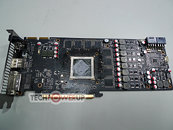
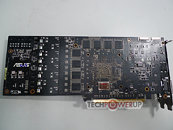
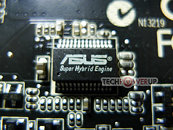
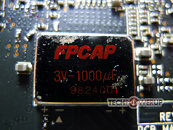
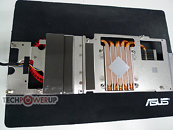
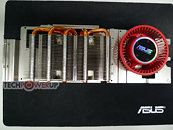
16 Comments on ASUS ROG Matrix HD 5870 Further Detailed
Why does the card look like it's been roasted (black around core), did W1zzard get his hands on it ?)
edit: top 4 memory chips not cooled at all? If you look at the cooler bottom it has thermal tape for the capasitor side row, but none under the pipes. (well air will still flow over there it seems)
I agree though no cooling for top set of ram with what is shown in these pictures perhaps there's there a separate plate for the ram to be cooled?
That sure is alot of rams :pimp:
BTT; card looks extremly nice but i guess the cash+ won't be worth it for the normal 5870 user not until there is competition that is
Hi, i just wanted to thank for up/d this tech nfo about this graphics card so thank you big man and hello to all the members to Techpowerup bye